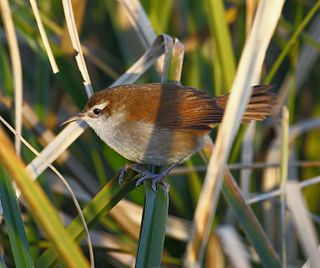
Ovenbirds or furnariids are a large family of small suboscine passerine birds found from Mexico and Central to southern South America. They form the family Furnariidae. This is a large family containing around 315 species and 70 genera. The ovenbird, which breeds in North America, is not a furnariid – rather it is a distantly related bird of the wood warbler family, Parulidae.

The woodcreepers (Dendrocolaptinae) comprise a subfamily of suboscine passerine birds endemic to the Neotropics. They have traditionally been considered a distinct family Dendrocolaptidae, but most authorities now place them as a subfamily of the ovenbirds (Furnariidae). They superficially resemble the Old World treecreepers, but they are unrelated and the similarities are due to convergent evolution. The subfamily contains 63 species in 16 genera.

The royal cinclodes is a Critically Endangered passerine bird in the Furnariinae subfamily of the ovenbird family Furnariidae. It is found in Bolivia and Peru.

The great xenops is a species of bird in the Furnariinae subfamily of the ovenbird family Furnariidae. It is endemic to eastern Brazil.

Cinclodes is a genus of passerine birds belonging to the ovenbird family Furnariidae. There are about a dozen species distributed across the southern and Andean regions of South America. They are terrestrial birds of open habitats, typically found near water such as mountain streams or the seashore where they forage for small invertebrates. They are stocky birds with strong legs and feet and pointed, slightly downcurved bills. The plumage is inconspicuous and mainly brown, often with a pale wingbar, stripe over the eye and corners to the tail. They have loud, trilling songs and often raise their wings while singing.

The white-browed foliage-gleaner is a Near Threatened species of bird in the Furnariinae subfamily of the ovenbird family Furnariidae.. It is found in Argentina, Brazil, and possibly Paraguay.

The bamboo foliage-gleaner, also known as the crested foliage-gleaner or dusky-cheeked foliage-gleaner, is a species of bird in the Furnariinae subfamily of the ovenbird family Furnariidae. It is found in Bolivia, Brazil, Colombia, Ecuador, and Peru.

The white-winged cinclodes is a species of bird in the Furnariinae subfamily of the ovenbird family Furnariidae. It is found in Argentina, Bolivia, Chile, and Peru.

The Cordoba cinclodes or Comechingones cinclodes is a species of bird in the Furnariinae subfamily of the ovenbird family Furnariidae. It is endemic to Argentina.

The stout-billed cinclodes is a species of bird in the Furnariinae subfamily of the ovenbird family Furnariidae. It is found in Colombia and Ecuador.

The buff-winged cinclodes is a species of bird in the Furnariinae subfamily of the ovenbird family Furnariidae. It is found in Argentina, Brazil, Chile, Paraguay, Uruguay and as a vagrant on the Falkland Islands.

The grey-flanked cinclodes, formerly known as Oustalet's cinclodes, is a species of bird in the Furnariinae subfamily of the ovenbird family Furnariidae. It is found in Argentina and Chile.

The long-tailed cinclodes is a Near Threatened species of bird in the Furnariinae subfamily of the ovenbird family Furnariidae. It is endemic to Brazil.

The dark-bellied cinclodes is a species of bird in the Furnariinae subfamily of the ovenbird family Furnariidae. It is found in Argentina and Chile.

The band-tailed earthcreeper is a species of bird in the Furnariinae subfamily of the ovenbird family Furnariidae. It is found in Argentina and Chile.

The curve-billed reedhaunter is a species of bird in the Furnariinae subfamily of the ovenbird family Furnariidae. It is found in Argentina, Brazil, and Uruguay.

The ochre-breasted foliage-gleaner is a species of bird in the Furnariinae subfamily of the ovenbird family Furnariidae. It is found in Argentina, Brazil, and Paraguay.

The lesser woodcreeper is a species of bird in the subfamily Dendrocolaptinae of the ovenbird family Furnariidae. It is found in Argentina, Brazil, and Paraguay.

The cream-winged cinclodes is a species of bird in the Furnariinae subfamily of the ovenbird family Furnariidae. It is found in Argentina, Bolivia, Chile, and Peru.

The Ceara woodcreeper or Atlantic woodcreeper is a Vulnerable species of bird in the subfamily Dendrocolaptinae of the ovenbird family Furnariidae. It is endemic to Brazil.






















